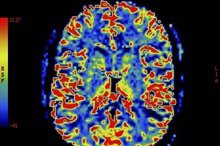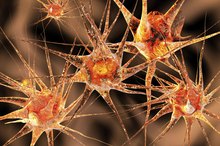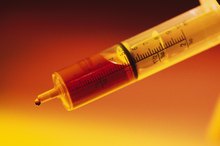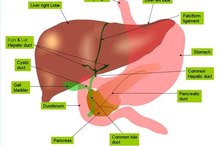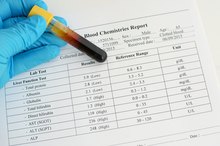Protein, Ammonia & Brain Damage
Ammonia is a byproduct of the metabolism of protein 3. Biochemical reactions in your body rapidly convert ammonia into less harmful molecules under normal conditions. Liver disease can cause ammonia levels to build up in your body. Your brain is normally protected from the low levels of ammonia in your body by the blood-brain barrier. Liver disfunction can cause ammonia levels to build up in your brain causing permanent brain damage, a condition known as hepatic encephalopathy.
If you are experiencing serious medical symptoms, seek emergency treatment immediately.
Protein and Ammonia
Protein, and the amino acids that comprise it, is the primary source of nitrogen for your body. Many parts of your body contain high amounts of nitrogen: proteins, enzymes, DNA and important biochemicals. Ammonia is produced during the breakdown of amino acids and other molecules in your body that contain nitrogen. Your liver, when healthy, will rapidly convert ammonia to urea, a nontoxic byproduct.
- Protein, and the amino acids that comprise it, is the primary source of nitrogen for your body.
- Ammonia is produced during the breakdown of amino acids and other molecules in your body that contain nitrogen.
The Blood-Brain Barrier
What Do Elevated CPK Levels in the Liver Indicate?
Learn More
Blood vessels supplying the brain have a specialized lining that is not found in other areas of your body. This special lining is called the blood-brain barrier. The BBB controls how nutrients and other chemicals enter the brain by actively transporting them from the blood to the brain. Only a very small amount of chemicals, such as ammonia, can leak across the BBB. However, as ammonia levels rise in the blood, more ammonia is leaked into the brain, potentially leading to brain damage.
- Blood vessels supplying the brain have a specialized lining that is not found in other areas of your body.
- Only a very small amount of chemicals, such as ammonia, can leak across the BBB.
Ammonia and Brain Damage
Ammonia is a highly reactive and caustic molecule. According to the National Institute of Alcohol Abuse and Alcoholism, high levels of ammonia in the brain can impair the function of, and eventually kill, two types of cells, neurons and astrocytes 1. Neurons are responsible for the electrical and chemical communication that underlies brain function. Astrocytes are support cells, removing chemicals such as ammonia from the brain. Ammonia disrupts energy production in the brain and interferes with communication between neurons. This damage leads to a condition, hepatic encephalopathy, that manifests as sleep disturbances, mood disorders, poor cognition, anxiety, depression and movement disorders.
- Ammonia is a highly reactive and caustic molecule.
- According to the National Institute of Alcohol Abuse and Alcoholism, high levels of ammonia in the brain can impair the function of, and eventually kill, two types of cells, neurons and astrocytes 1.
Causes of High Brain Ammonia
Important Energy Sources for the Brain
Learn More
Liver disease is the primary cause of high ammonia in the brain. Alcohol-related liver disease, such as hepatitis and cirrhosis, commonly lead to ammonia-induced brain damage. Genetic deficiencies, called urea cycle disorders, in the enzymes that process ammonia into urea can cause high ammonia. High-protein diets can contribute to high ammonia levels. In general, continue to eat protein, but avoid eating large amounts in a single meal. Discuss your diet and what foods to avoid with your doctor.
- Liver disease is the primary cause of high ammonia in the brain.
- Genetic deficiencies, called urea cycle disorders, in the enzymes that process ammonia into urea can cause high ammonia.
Related Articles
References
- National Institute of Alcohol Abuse and Alcoholism: Hepatic Encephalopathy–A Serious Complication of Alcoholic Liver Disease; R.F. Butterworth, Ph.D. D.Sc.; July 2004
- "Principles of Neural Science," 4th ed.; E. R. Kandel , J. H. Schwarz and T.M. Jessel; 2000
- Cornell University: Ammonia & Urea Metabolism
- Ah Mew N, Simpson KL, Gropman AL, et al. Urea cycle disorders: Overview. 2003 Apr 29 [Updated 2017 Jun 22]. In: Adam MP, Ardinger HH, Pagon RA, et al., editors. GeneReviews® [Internet]. Seattle (WA): University of Washington, Seattle; 1993-2018.
- Häberle J, Boddaert N, Burlina A, et al. Suggested guidelines for the diagnosis and management of urea cycle disorders. Orphanet J Rare Dis. 2012 May 29;7:32. doi:10.1186/1750-1172-7-32
Writer Bio
Chris Daniels covers advances in nutrition and fitness online. Daniels has numerous certifications and degrees covering human health, nutritional requirements and sports performance. An avid cyclist, weightlifter and swimmer, Daniels has experienced the journey of fitness in the role of both an athlete and coach.

